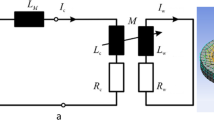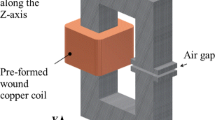Abstract
Optimization of forming processes seeks an optimal choice of many process parameters. In Electromagnetic Material Forming (EMF), parameters associated to the geometry of the forming device or related to the generation of the pulsed currents have to be set, and are of primary importance to achieve the proper geometry of the formed part. Usual optimization procedures proceed by defining a trial choice of the set of parameters and then evaluate the optimality of a given cost function computed from a direct analysis. This iterative process requires many assessments of the cost function and may lead to a prohibitive computation cost since the direct analysis may involve a structural analysis. Others approaches have been proposed to circumvent this problem; based on a separated representation of the solution, the Proper Generalized Decomposition allows for a parametric resolution by introducing optimization parameters as extra-coordinates of the problem, hence the optimization procedure reduces to a simple post-treatment of the multidimensional numerical solution. The aim of this work is to develop a numerical tool dedicated to the optimization of the design of an electromagnetic compression device. This tool should enable to optimize process parameters of the generator and geometrical parameters of the electromagnetic forming device by solving the set of electromagnetic equations in quasistatics. To this end, we take advantage of the Proper Generalized Decomposition (PGD) to perform a parametric resolution. We show solutions computed with a parameterization of the discharged current, and with a parameterization of the geometry considering a multi-layered structure. Finally, an example of optimization procedure is shown on the latter solution, seeking the configuration maximising the radial component of the resultant compression force applied on the part to be formed.











Similar content being viewed by others
References
COMSOL® AC/DC (2012) User’s manual
Paraview 4.2 (2015). http://www.paraview.org/
Ammar A, Normandin M, Daim F, Gonzalez D, Cueto E, Chinesta F (2010) Non incremental strategies based on separated representations: applications in computational rheology. Commun Math Sci 8(3):671–695
Arora J, Wang Q (2005) Review of formulations for structural and mechanical system optimization. Struct Multidiscip Optim 30(4):251–272
Balanethiram V, Daehn G (1992) Enhanced formability of interstitial free iron at high strain rates. Scr Metall Mater 27:1783–1789
Balanethiram V, Daehn G (1994) Hyperplasticity-increased forming limits at high workpiece velocities. Scr Metall Mater 31:515–520
Bognet B, Bordeu F, Chinesta F, Leygue A, Poitou A (2012) Advanced simulation of models defined in plate geometries: 3D solutions with 2D computational complexity. Comput Methods Appl Mech Eng 201:1–12
Bordeu F (2013) Pxdmf tools for paraview 3.98.1. http://rom.research-centrale-nantes.com/ http://rom.research-centrale-nantes.com/
Brett W, Tamara G, et al. (2012) Matlab tensor toolbox version 2.5. http://www.sandia.gov/%7Etgkolda/TensorToolbox/
Chinesta F, Ammar A, Cueto E (2010) Recent advances and new challenges in the use of the proper generalized decomposition for solving multidimensional models. Arch Comput methods Eng 17 (4):327–350
Chinesta F, Leygue A, Bognet B, Ghnatios C, Poulhaon F, Bordeu F, Barasinski A, Poitou A, Chatel S, Maison-Le-Poec S (2014) First steps towards an advanced simulation of composites manufacturing by automated placement. Int J Mater Form 7(1):81–92
Chinesta F, Leygue A, Bordeu F, Aguado J, Cueto E, Gonzalez D, Alfaro I, Ammar A, Huerta A (2013) PGD-Based computational vademecum for efficient design, optimization and control. Archives of Computational Methods in Engineering 20(1):31–59
El-Azab A, Garnich M, Kapoor A (2003) Modeling of the electromagnetic forming of sheet metals: state-of-the-art and future needs. J Mater Process Technol 142:744–754
Eringen A, Maugin G (1990) Electrodynamics of continua, vol I, II. Springer, New York
Falcó A On the optimization problems for the proper generalized decomposition and the n-best term approximation. In: Proceedings of the 7th international conference on engineering computational technology
Fenton G, Daehn G (1998) Modeling of electromagnetically formed sheet metal. J Mater Process Technol 75:6–16
Feynman R, Leighton R, Sands M (1965) The Feynman lectures on pPhysics: Vol. 2: The electromagnetic field. Addison-Wesley
Ghnatios C, Chinesta F, Cueto E, Leygue A, Poitou A, Breitkopf P, Villon P (2011) Methodological approach to efficient modeling and optimization of thermal processes taking place in a die: Application to pultrusion. Compos A: Appl Sci Manuf 42(9):1169–1178
Ghnatios C, Masson F, Huerta A, Leygue A, Cueto E, Chinesta F (2012) Proper generalized decomposition based dynamic data-driven control of thermal processes. Comput Methods Appl Mech Eng 213:29–41
Giner E, Bognet B, Rodenas J, Leygue A, Fuenmayor F, Chinesta F (2013) The proper generalized decomposition (PGD) as a numerical procedure to solve 3D cracked plates in linear elastic fracture mechanics. Int J Solids Struct 50:1710–1720
Harshman R, Lundy M (1994) PARAFAC: Parallel factor analysis. Comput Stat Data Anal 18(1):39–72
Henneron T, Clénet S Proper generalized decomposition method to solve quasi static field problems
Heyberger C, Boucard P, Néron D (2012) Multiparametric analysis within the proper generalized decomposition framework. Comput Mech 49:277–289
Lathauwer LD, Moor BD, Vandewalle J (2000) A multilinear singular value decomposition. SIAM Journal on Matrix Analysis and Applications 21(4):1253–1278
Leygue A, Verron E (2010) A first step towards the use of Proper General Decomposition. Methods for structural optimization. Archives of Computational Methods in Engineering 17:465–472
Nouy A (2010) A priori model reduction through Proper Generalized Decomposition for solving time-dependent partial differential equations. Comput Methods Appl Mech Eng 199(23-24):1603–1626
Nouy A (2010) Proper generalized decompositions and separated representations for the numerical solution of high dimensional stochastic problems. Archives of Computational Methods in Engineering 17:403–434
Ogden R (2009) Incremental elastic motions superimposed on a finite deformation in the presence of an electromagnetic field. International Journal of Non-Linear Mechanics 44:570–580
Pruliere E, Chinesta F, Ammar A (2010) On the deterministic solution of multidimensional parametric models using the proper generalized decomposition. Math Comput Simul 81:791–810
Psyk V, Rich D, Kinsey B, Tekkaya AE, Kleiner M (2011) Electromagnetic metal forming - A review. J Mater Process Technol 211:787–829
Robin V, Feulvarch E, Bergheau J (2008) Modélisation tridimensionnelle du procédé de mise en forme électromagnétique. Mécanique & Industries 9(2):133–138
Ryckelynck D, Chinesta F, Cueto E, Ammar A (2006) On the a priori model reduction: overview and recent developments. Archives of Computational methods in Engineering 13(1):91–128
Stiemer M, Unger J, Svendsen B, Blum H (2006) Algorithmic formulation and numerical implementation of coupled electromagnetic-inelastic continuum models for electromagnetic metal forming. Int J Numer Methods Eng 68:1301–1328
Svendsen B, Chanda T (2005) Continuum thermodynamic formulation of models for electromagnetic thermoinelastic solids with application in electromagnetic metal forming. Contin Mech Thermodyn 17(1):1–16
Thomas J, Triantafyllidis N (2009) On electromagnetic forming processes in finitely strained solids: Theory and examples. Journal of the Mechanics and Physics of Solids 57:1391–1416
Author information
Authors and Affiliations
Corresponding author
Rights and permissions
About this article
Cite this article
Heuzé, T., Leygue, A. & Racineux, G. Parametric modeling of an electromagnetic compression device with the proper generalized decomposition. Int J Mater Form 9, 101–113 (2016). https://doi.org/10.1007/s12289-014-1212-9
Received:
Accepted:
Published:
Issue Date:
DOI: https://doi.org/10.1007/s12289-014-1212-9




